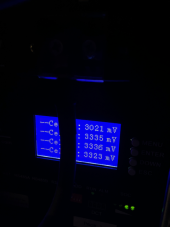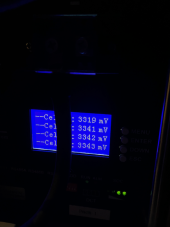jameshowison
New Member
- Joined
- Jul 30, 2021
- Messages
- 184
Could someone suggest troubleshooting steps?
Server rack LFP battery. Was stored (at 95%) for 2 months. Previously working fine.
The battery can’t effectively charge because one cell triggers OVP. It shows at 3.5v and rises to 3.7 if any substantial current is applied. Other cells are all around 3.3v. Capacity shows 25% but up to 35% after charging at 2A overnight.
Worryingly that same cell shows low voltage (drops to showing 3.1) when some decent load applied.
Any chance this is just balancing or similar? Should I reduce charging voltage?
It’s hard to extract from RV, but I guess check connections? Could a loose connection show those symptoms? (I would have thought high resistance would mean slow charge and discharge?)
Other suggestions?
Thanks,
James
Server rack LFP battery. Was stored (at 95%) for 2 months. Previously working fine.
The battery can’t effectively charge because one cell triggers OVP. It shows at 3.5v and rises to 3.7 if any substantial current is applied. Other cells are all around 3.3v. Capacity shows 25% but up to 35% after charging at 2A overnight.
Worryingly that same cell shows low voltage (drops to showing 3.1) when some decent load applied.
Any chance this is just balancing or similar? Should I reduce charging voltage?
It’s hard to extract from RV, but I guess check connections? Could a loose connection show those symptoms? (I would have thought high resistance would mean slow charge and discharge?)
Other suggestions?
Thanks,
James





